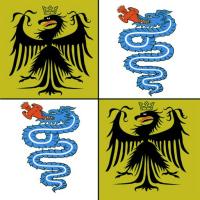 image
by Matteo Colaone, 21 August 2000
image
by Matteo Colaone, 21 August 2000
Last modified: 2014-02-24 by rob raeside
Keywords: italy | insubria | bellinzona | ticino | lombardy | milan | eagle | lombardo veneto kingdom | serpent |
Links: FOTW homepage |
search |
disclaimer and copyright |
write us |
mirrors
 image
by Matteo Colaone, 21 August 2000
image
by Matteo Colaone, 21 August 2000
See also:
That is the historical region where I live [=Lumbardia
Ucidental/Western Lombardy(I) + Cantun
Tisin/Canton Ticino (CH)]. Insubria flag was born on tne 5th
september 1395, created by Emperor Venceslao of Holy Roman Empire
for Duca Gian Galeazzo Visconti of Milan
Matteo Colaone, 21 August 2000
I see a connection with Ticino by the II and III quarters,
showing a charge quite similar to the arms of Bellinzona. What
about the other quarters, what does the black eagle on gold stand
for? Roman Empire, in any of it's incarnations?...
Antonio Martins, 30 August 2000
Antonio is absolutely right here, the serpent (in italian
"biscione") appearing on this flag is the same as the
one appearing on the arms and on the flag of Bellinzona (Ticino).
Pascal Gross, 30 August 2000
Insubria is another term to refer to Western Lombardy. It is
taken from the celtic tribe (Insubrae) which settled between the
Tessin and the Adda rivers in ancient times. The heraldic flag is
the historical banner of the Dukedom of Milan. It was granted by
the emperor Wenceslaw in 1395 to Gian Galeazzo Visconti first
duke of Milan, being the dukedom part of the Holy Roman Empire.
That is why the black eagle appears in the first and fourth
quarter. The figure in the second and third quarter is the
traditional heraldic simbol of the possessions of Milan first and
the Dukedom after. Possession which included the whole of nowdays
Western Lombardy, parts of Piedmond and the whole of Canton
Tessin in Switzerland. That is also why the City of Bellinzona
still bears the same arms today (in different colours though and
without the moor in the mouth of the snake. Bellinzona was always
one of the most faithfull cities of the dukedom) and why the
people on both side of t! he border speak the same language (that
is western lombard). The origin of the use of the snake, apart
from the legends, dates back to the first crusade when it was
granted by the municipality of Milan to Ottone Visconti one of
the leaders of the lombard contingent. Since then it has
rappresented the arms of the State of Milan. The flag has been
the official emblem of the Dukedom from 1395 till 1796 when
Napoleon dismantled it (together with the Holy Roman Empire) and
it appears also in the arms of every emperor of the house of
Hapsburg from Carl the fifth onwards (having carried the emperors
themselves the title of Duke of Milan after the death of the last
Sforza). When the Hapsburgs will re-enter their possessions in
1815 after Napoleon's fall the dukedom will be unified with the
former Republic of Venice and Dukedom of Mantua to form the Lombardo -Veneto kingdom.
GianPietro Gallinelli, 29 September 2000
The Padan's Insubria flag was first presented on 4th of June
2000 at Pontida (Bg), Lombardia by Cultural Association
"Terra Insubre". See http://www.terrainsubre.com/il_simbolo.htm.
Matteo Colaone, 4 October 2000
In Milan (Lombardy, Italy) page, Jaume
Olle said: "Visconti flag 1277-1397. Reconstructed from
writen descriptions.
In 1397 the use of imperial eagle was granted by Empeor" .
Above GianPietro Gallinelli said: "It was granted
by the emperor Wenceslaw in 1395 to Gian Galeazzo Visconti first
duke of Milan, being the dukedom part of the Holy Roman Empire.
That is why the black eagle appears in the first and fourth
quarter."
In conclusion the image at Milan's page is, chronologically, the
first flag of the Dukedom, and the above flag was the evolution
after 1395 of the previous flag , so it should be considered as a
political flag in its modern use (autonomist of Insubria), but it
is also an historical flag of Milano and Western Lombardy.
Matteo Colaone, 11 November 2000
This flag is not to be considered a "Padanian" flag,
as it has directly nothing to do with the Padanian or Northern
League movement. The Insubrian flag (also called
"Ducale") is simply the historical flag of the Duchy of
Milan (Ducato di Milano). This land is also called Insubria: this
name is currently used in historical, folkloric, socio-economical
and association fields. The flag started to be used with quite a
political aim by the Insubrian autonomists after its
"rediscovery" in 2000.
Matteo Colaone, 28 June 2005